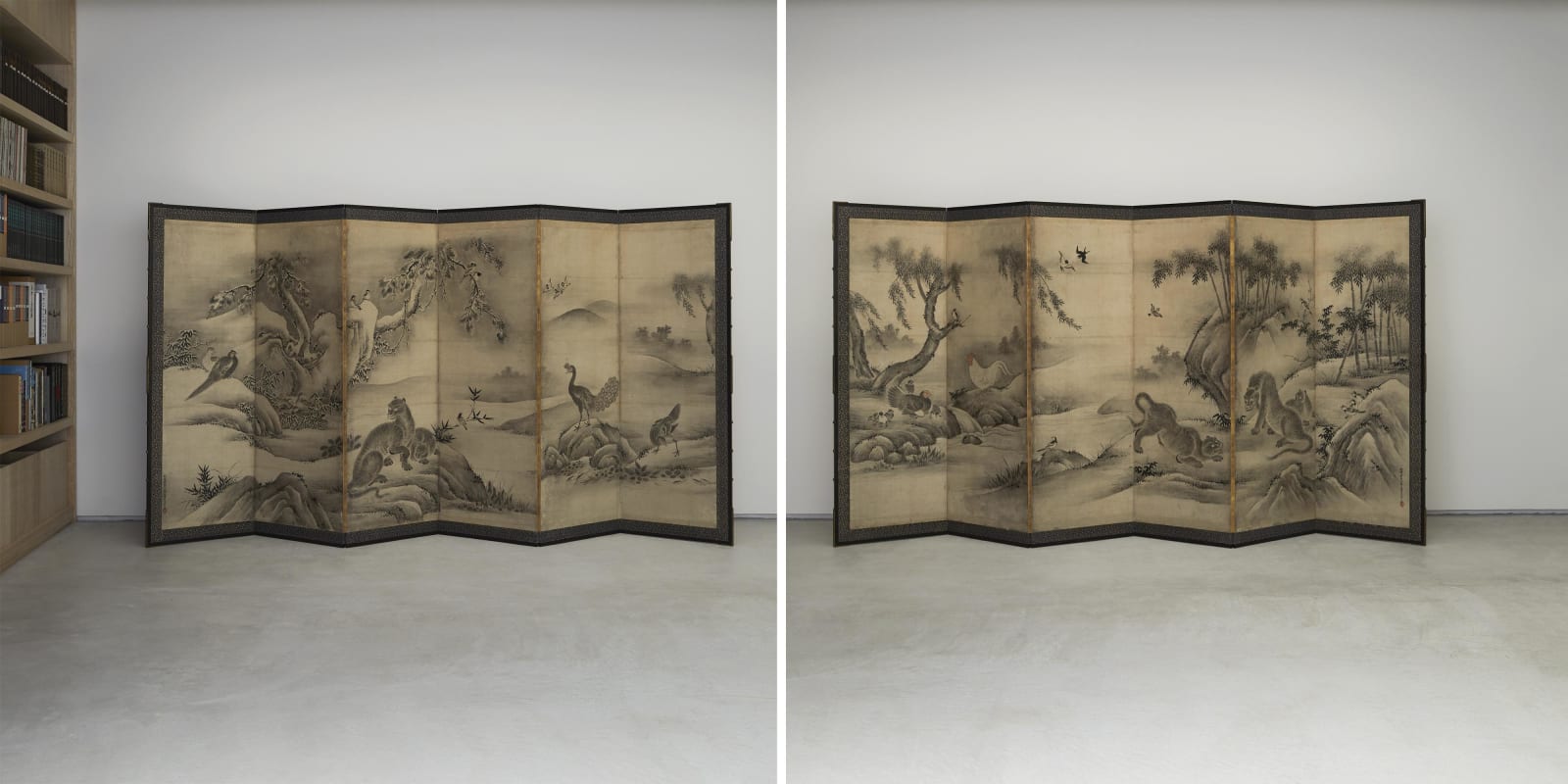Kanō Motonobu (1477–1559)
Birds and Flowers
Ink and light color on paper, pair of six-panel folding screens
At the age of 81
Seal: Motonobu (each)
182 x 371 cm each (overall)
Further images
A copy of the present folding screens exists. In the opinion of Tsuji Nobuo, the original of that copy might be attributed to Kano Shoei judging on its feature of tigers. The similar expression of the rooster and the hen with chicks is seen in Birds and Flowers by Shoei in the Boston Museum of Fine Arts. In general, the image of chicken derives from the Chinese originals: the hen and the chick are after Muqi’s style and the rooster is in the manner of Muqi’s pupil, Luo Chuang. By observing the hen with the chicks and the rooster in the present work, its style appears closer to the Chinese originals. The peacocks in the right screen are extremely similar with the ones in Birds and Flowers of the Four Seasons, attributed to Motonobu, in the Nezu Museum, while the trees in the winterscape in the left screen can be observed in Motonobu’s work Birds and Flowers in the Snow, done and signed at his seventy-nine. In composition, the expression of the snow-covered ground, reeds, and other motifs, as well as the discontinuity between fore and back scenes in this work shows that it is a variation from Motonobu’s gyo, or semi-formal, style work of Birds and Flowers. Also, the trees and the objects scattered in both screens are depicted in a relatively smaller size that results in a stylized imagery, which is considered as the characteristic of Motonobu’s last years.
Each screen bears Motonobu’s signature at eighty-one, two years before his death. The said signature resembles to the one seen in The Sixteen Arhats, done at seventy-five, in the Hompo-ji Temple. Today, most of the works in the style of Motonobu, even with his signature, are ascribed to the atelier of Motonobu, and perhaps the same can be said of this work. Nevertheless, it is fair to say this work manifests the aesthetics of last years’ Motonobu.
Kano Motonobu (painter; 1477–1559)
Also known as Eisen, Gyokusen, Kohogen, Echizen-no-kami.
Kyoto-born late Muromachi period painter. The second-generation head master of the Kano school. Eldest son of Kano Masanobu. Skilled in painting since his youth. Studied from the Song and Yuan dynasties’ masters, Tosa school artists, Shubun, and Sesshu. His paintings feature meticulousness and refinement. Excelled in wide-range subjects such as landscape, portrait, and bird-and-flower. Recognized as one of the three greatest masters of his time together with Tosa Mitsunobu and Sesshu. His residential area granted by the Ashikaga shogunate was called Kano zushi.
Each screen bears Motonobu’s signature at eighty-one, two years before his death. The said signature resembles to the one seen in The Sixteen Arhats, done at seventy-five, in the Hompo-ji Temple. Today, most of the works in the style of Motonobu, even with his signature, are ascribed to the atelier of Motonobu, and perhaps the same can be said of this work. Nevertheless, it is fair to say this work manifests the aesthetics of last years’ Motonobu.
Kano Motonobu (painter; 1477–1559)
Also known as Eisen, Gyokusen, Kohogen, Echizen-no-kami.
Kyoto-born late Muromachi period painter. The second-generation head master of the Kano school. Eldest son of Kano Masanobu. Skilled in painting since his youth. Studied from the Song and Yuan dynasties’ masters, Tosa school artists, Shubun, and Sesshu. His paintings feature meticulousness and refinement. Excelled in wide-range subjects such as landscape, portrait, and bird-and-flower. Recognized as one of the three greatest masters of his time together with Tosa Mitsunobu and Sesshu. His residential area granted by the Ashikaga shogunate was called Kano zushi.











